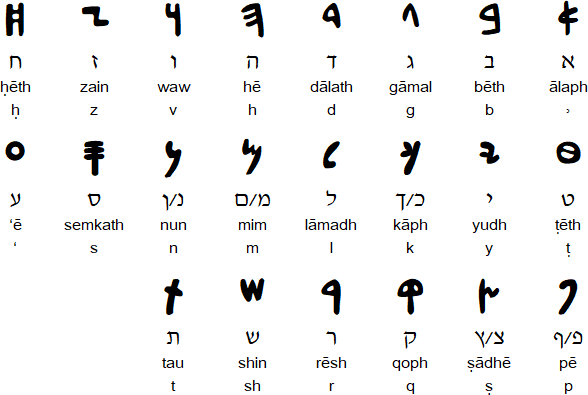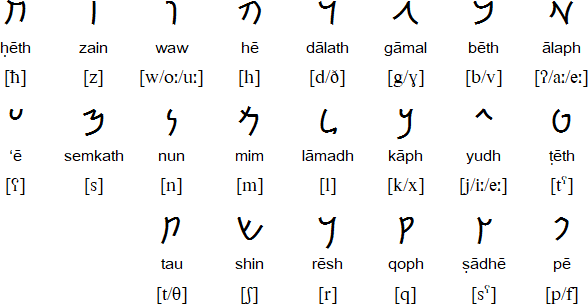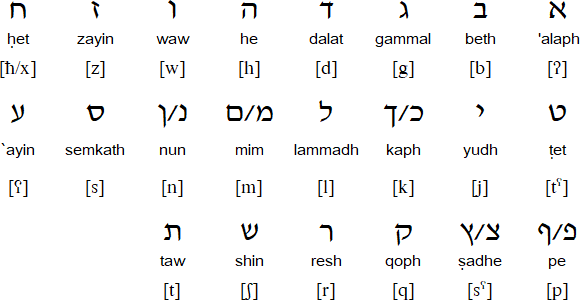![]()
Aramaic is a Semitic language which was the lingua franca of much of the Near East from about 7th century BC until the 7th century AD, when it was largely replaced by Arabic. Classical or Imperial Aramaic was the main language of the Persian, Babylonian and Assyrian empires and spread as far as Greece and the Indus valley.
After Alexander the Great destroyed the Persian Empire, Aramaic ceased to be the official language of any major state, though continued to be spoken widely. It was during this period that Aramaic split into western and eastern dialects.
Aramaic was once the main language of the Jews and appears in some of the Dead Sea Scrolls. It is still used as a liturgical language by Christian communities in Syria, Lebanon and Iraq, and is spoken by small numbers of people in Iraq, Turkey, Iran, Armenia, Georgia and Syria.
Today Biblical Aramaic, Jewish Neo-Aramaic dialects and the Aramaic language of the Talmud are written in the Hebrew alphabet, while the Syriac alphabet is used to write Syriac and Christian Neo-Aramaic dialects, and the Mandaic alphabet is used for Mandaic.
The Aramaic alphabet was adaptaed from the Phoenician alphabet during the 8th century BC and was used to write the Aramaic language until about 600 AD. The Aramaic alphabet was adapted to write quite a few other languages, and developed into a number of new alphabets, including the Hebrew square script and cursive script, Nabataean, Syriac, Palmyrenean, Mandaic, Sogdian, Mongolian and probably the Old Turkic script.
The Early Aramaic alphabet was developed sometime during the late 10th or early 9th century BC and replaced Assyrian cuneiform as the main writing system of the Assyrian empire.

This version of the Aramaic alphabet dates from the 5th century BC and was used to write Imperial Aramaic, the standardised and offical language of the Archaemenid Empire. It was adapted to write Hebrew during the 5th century BC, and the modern version shown below is still used to write Neo-Aramaic dialects.


Download Aramaic alphabet charts in Excel or PDF format
Yàlidïn ìnon čol-ènašëya čwaþ χeḁrrëya we šàwyëya va ǧurča we va zìdqëya. Bìyìzvədun yal χuešaba we yal þeḁrþa, we koyìsˀərun χàd ləwaþ χàd va ruχa di àχuþa.
A recording of this text by Yaqob bar-Karoza
All human beings are born free and equal in dignity and rights. They are endowed with
reason and conscience and should act towards one another in a spirit of brotherhood.
(Article 1 of the Universal Declaration of Human Rights)
Information about Aramaic | Phrases | Numbers | Tower of Babel
Details of the Latinate (Aramaic) Script
Information about the Aramaic alphabet and language
http://en.wikipedia.org/wiki/Aramaic_alphabet
http://en.wikipedia.org/wiki/Aramaic_language
http://jesusspokearamaic.com
Online Aramaic lessons
http://www.learnassyrian.com
http://wn.com/Modern_Aramaic
Aramaic dictionary
http://www.peshitta.org/lexicon/
Aramaic fonts
http://www.historian.net/files.htm
Aramaic Peshitta Bible Repository
http://www.aramaicpeshitta.com
Aramaic Designs - Aramaic Translations & Classes
http://www.AramaicDesigns.com
Aramaic, Bukhori, Domari, Hebrew, Jewish Neo-Aramaic, Judeo-Arabic, Judeo-Persian, Juhuri, Knaanic, Ladino, Mozarabic, Yiddish, Yevanic
Akkadian, Amharic, Arabic (Algerian), Arabic (Bedawi), Arabic (Chadian), Arabic (Egyptian), Arabic (Gulf), Arabic (Hassaniya), Arabic (Hejazi), Arabic (Lebanese), Arabic (Modern Standard), Arabic (Moroccan), Arabic (Najdi), Arabic (Syrian), Aramaic, Argobba, Assyrian / Neo-Assyrian, Canaanite, Chaha, Chaldean Neo-Aramaic, Ge'ez, Hadhramautic, Harari, Hebrew, Himyaritic, Jewish Neo-Aramaic, Maltese, Mandaic, Nabataean, Neo-Mandaic, Phoenician, Punic, Qatabanic, Sabaean, Sabaic, Silt'e, Syriac, Tigre, Tigrinya, Turoyo, Ugaritic, Western Neo-Aramaic
Ancient Berber, Arabic, Aramaic, Chorasmian, Elymaic, Hatran, Hebrew, Manichaean, Nabataean, North Arabian, Pahlavi, Palmyrene, Parthian, Phoenician, Paleo-Hebrew, Proto-Sinaitic / Proto-Canaanite, Psalter, Punic, Sabaean, Samaritan, Sogdian, South Arabian, Syriac, Tifinagh, Ugaritic
Page last modified: 02.10.23
[top]
Why not share this page:

If you like this site and find it useful, you can support it by making a donation via PayPal or Patreon, or by contributing in other ways. Omniglot is how I make my living.
Note: all links on this site to Amazon.com, Amazon.co.uk
and Amazon.fr
are affiliate links. This means I earn a commission if you click on any of them and buy something. So by clicking on these links you can help to support this site.
Get a 30-day Free Trial of Amazon Prime (UK)
If you're looking for home or car insurance in the UK, why not try Policy Expert?
[top]